When your red blood cell count drops below normal levels, your body struggles to deliver enough oxygen to your tissues and organs. Low RBC count, also known as anemia, causes your body to work much harder to supply oxygen throughout your system, leading to fatigue, weakness, and shortness of breath.
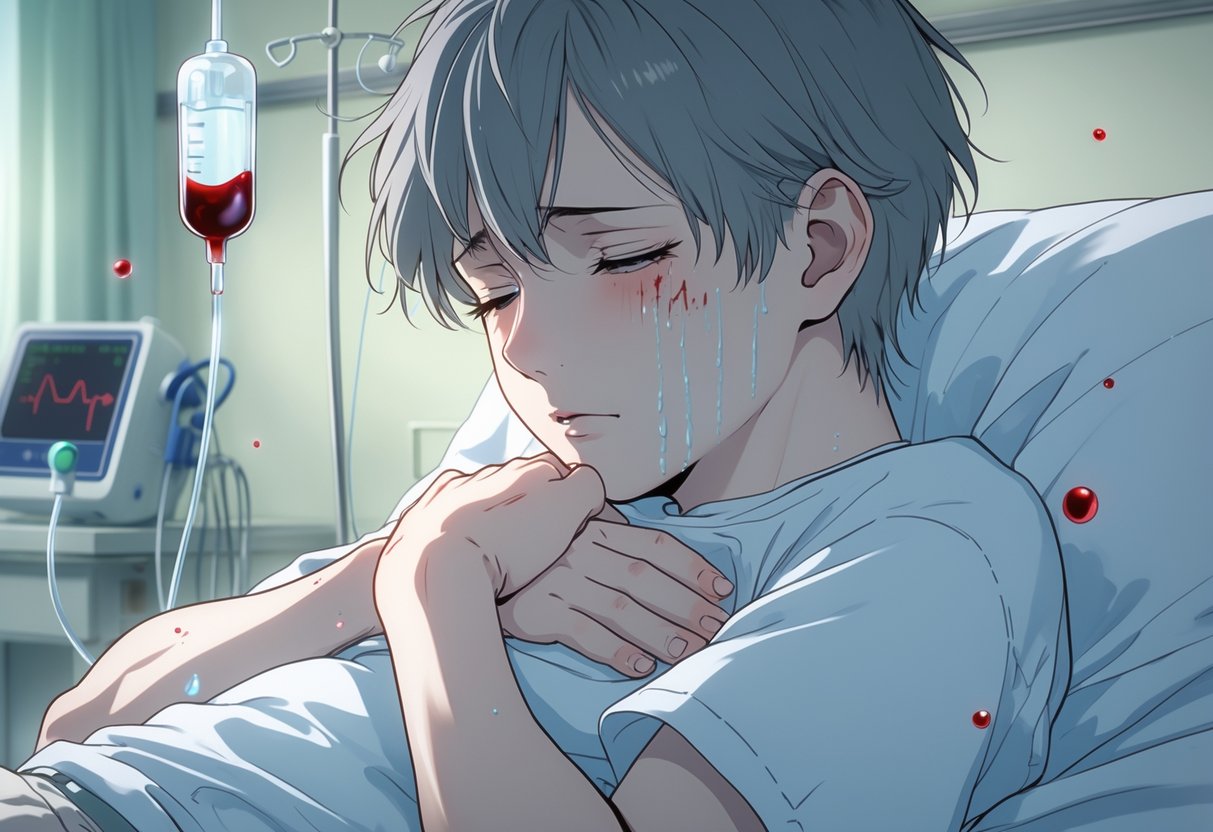
Red blood cells carry oxygen from your lungs to every part of your body[1] through a protein called hemoglobin. Normal RBC counts range from 4.2 to 5.4 million cells per microliter for women and 4.7 to 6.1 million cells per microliter for men. When these numbers fall below normal, the effects can range from mild tiredness to serious health complications.
The impact of low RBC count extends beyond just feeling tired. Your heart may beat faster as it tries to pump more blood to compensate for the reduced oxygen-carrying capacity. Many people with low red blood cell counts experience pale skin, difficulty concentrating, and loss of appetite[2]. Understanding what happens to your body during this condition can help you recognize the signs and seek appropriate treatment.
Key Takeaways
- Low RBC count forces your body to work harder to deliver oxygen, causing fatigue and breathing problems
- Common symptoms include weakness, pale skin, fast heartbeat, and trouble concentrating
- Treatment depends on the underlying cause and may include dietary changes, supplements, or medical interventions
Understanding Red Blood Cells and Their Role
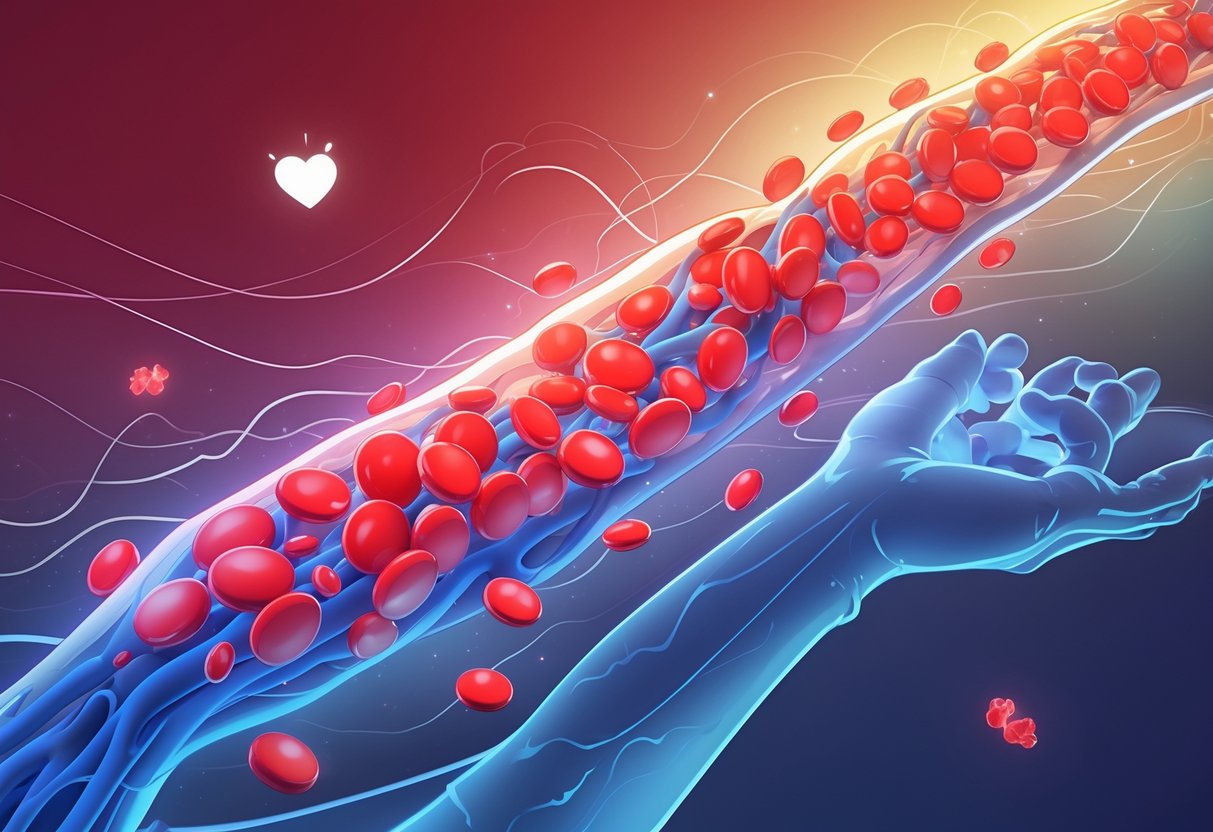
Red blood cells are essential components that carry oxygen throughout the body using hemoglobin, an iron-rich protein. When RBC levels drop, the body’s oxygen delivery system becomes compromised, affecting how tissues and organs function.
What Are Red Blood Cells?
Red blood cells, also called RBC or erythrocytes, are specialized cells that make up about 45% of total blood volume. These cells have a unique disc shape that helps them move through tiny blood vessels.
RBC are produced in the bone marrow through a process that takes about seven days. A healthy adult has millions of these cells in each drop of blood.
The main job of red blood cells is to transport gases. They pick up oxygen in the lungs and deliver it to tissues throughout the body.
Red blood cells live for about 120 days before the body breaks them down. The bone marrow must constantly make new RBC to replace the old ones.
These cells contain no nucleus, which gives them more space to carry oxygen. This design makes them very efficient at their main function.
Functions of Hemoglobin
Hemoglobin is an iron-rich protein inside red blood cells that gives blood its red color. Each RBC contains about 280 million hemoglobin molecules.
This protein has four parts that can each bind to one oxygen molecule. Hemoglobin attaches to oxygen in the lungs and carries it to tissues throughout the body[3].
When hemoglobin picks up oxygen, it becomes bright red. After releasing oxygen to tissues, it turns darker red.
Hemoglobin also helps remove carbon dioxide from tissues. It carries this waste gas back to the lungs where people exhale it.
Iron is crucial for hemoglobin to work properly. Without enough iron, the body cannot make healthy hemoglobin or enough red blood cells.
How Oxygen Is Delivered in the Body
Red blood cells bring oxygen to tissues and release carbon dioxide to the lungs for exhalation[4]. This process happens millions of times each minute as blood flows through the circulatory system.
The heart pumps oxygen-rich blood from the lungs to all body parts. Red blood cells travel through arteries, then smaller vessels called capillaries.
In the capillaries, hemoglobin releases oxygen to hungry tissues. The cells use this oxygen to make energy for basic functions like thinking, moving, and digesting food.
At the same time, tissues give carbon dioxide waste to the red blood cells. The RBC carry this waste back through veins to the lungs.
Hematocrit measures the percentage of blood made up of red blood cells. Normal hematocrit levels show the body has enough RBC to deliver adequate oxygen to all tissues.
How a Low RBC Count Impacts the Body
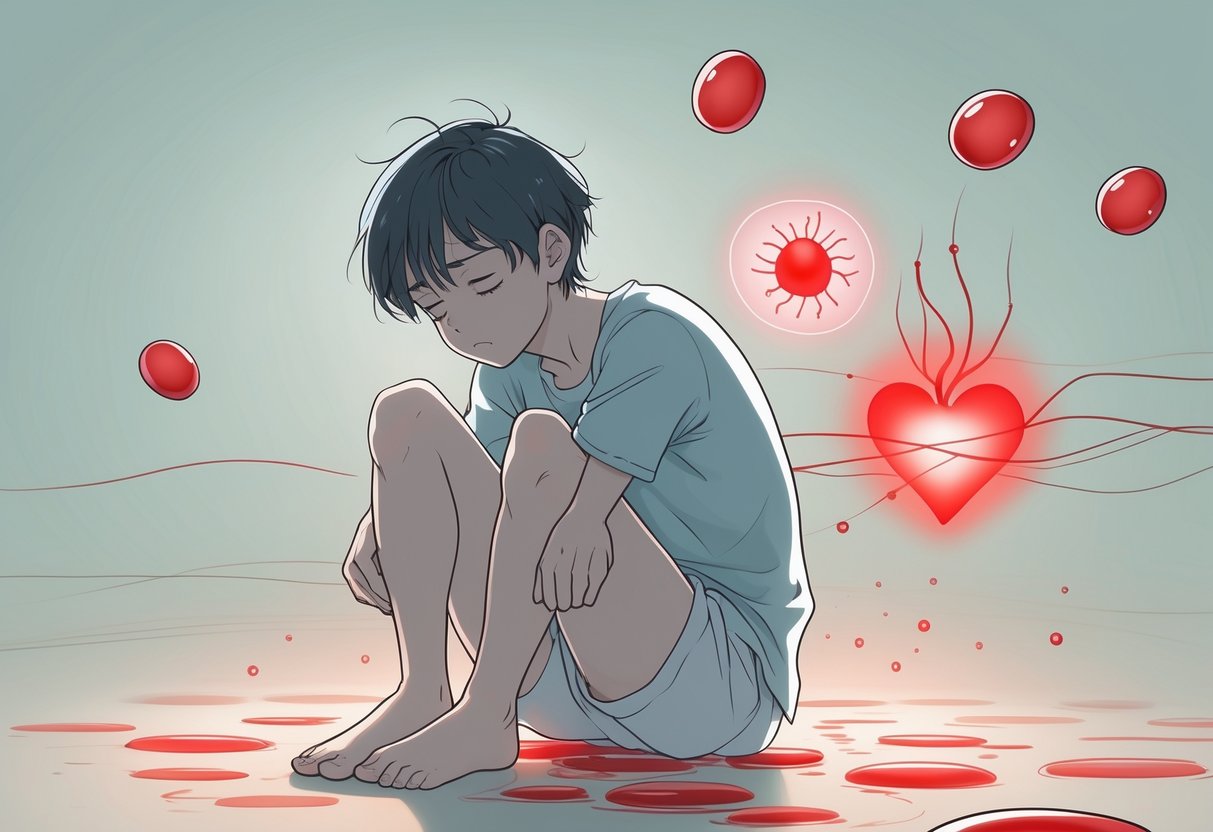
When red blood cell count drops below normal levels, the body struggles to deliver adequate oxygen to tissues and organs. This oxygen shortage creates a cascade of symptoms and complications that can affect every major system in the body.
Reduced Oxygen Supply to Tissues
Red blood cells carry oxygen from the lungs to every part of the body through hemoglobin, a protein that binds to oxygen molecules. When someone has low red blood cell count[5], their blood cannot transport enough oxygen to meet their body’s needs.
The most immediate effect is tissue hypoxia, where cells do not receive enough oxygen to function properly. This oxygen deficit forces the body to work harder to maintain basic functions.
Common signs of reduced oxygen delivery include:
- Pale skin, especially around the fingernails and inside the eyelids
- Cold hands and feet due to poor circulation
- Shortness of breath during normal activities
- Rapid heartbeat as the heart pumps faster to circulate available oxygen
The severity of symptoms depends on how low the red blood cell count has dropped and how quickly the anemia developed.
Consequences for Major Organs
The heart bears the greatest burden when red blood cell count is low. It must pump faster and work harder to circulate the reduced amount of oxygen-carrying blood throughout the body.
Over time, this extra workload can lead to heart problems. The heart muscle may become enlarged or weakened from the constant strain. In severe cases, anemia can contribute to heart failure[6], especially in people who already have heart disease.
Brain function also suffers from oxygen shortage:
- Difficulty concentrating and memory problems
- Headaches and dizziness
- Mood changes and irritability
The kidneys may reduce their function when oxygen levels drop. They produce less of a hormone called erythropoietin, which normally signals the bone marrow to make more red blood cells.
Exacerbation of Existing Health Problems
Low red blood cell count makes existing medical conditions worse. People with heart disease face higher risks because their hearts cannot handle the extra stress of pumping harder.
Diabetes becomes more difficult to manage when tissues do not receive adequate oxygen. Poor oxygen delivery can slow wound healing and increase infection risk.
Anemia particularly worsens these conditions:
| Health Problem | How Anemia Makes It Worse |
|---|---|
| Heart disease | Forces heart to work harder, may trigger chest pain |
| Lung disease | Compounds breathing difficulties |
| Kidney disease | Reduces kidney function further |
| Immune disorders | Increases susceptibility to infections |
People recovering from surgery or illness need more time to heal when their red blood cell count is low. The body cannot repair tissues efficiently without adequate oxygen supply.
Chronic fatigue becomes overwhelming for many people with anemia. Simple daily activities like climbing stairs or walking short distances become exhausting because muscles do not receive enough oxygen to function normally.
Common Signs and Symptoms of Low RBC Count

Low red blood cell counts cause specific symptoms as the body struggles to get enough oxygen. These symptoms range from constant tiredness and breathing problems to heart issues and dizzy spells.
Tiredness and Weakness
Fatigue is the most common symptom when red blood cells are low[5]. People feel tired even after getting enough sleep. This happens because the body’s cells don’t get enough oxygen to work properly.
The tiredness feels different from normal tiredness. It doesn’t go away with rest. Simple tasks like walking up stairs or carrying groceries become difficult.
Weakness often comes with the fatigue. Muscles feel heavy and hard to move. People may need to sit down more often during daily activities.
Common fatigue symptoms include:
- Feeling tired all day long
- Needing more sleep than usual
- Trouble staying awake during the day
- Feeling weak in arms and legs
Shortness of Breath and Chest Pain
Breathing problems happen when oxygen levels drop[6]. The heart works harder to pump blood around the body. This makes people feel short of breath during normal activities.
Shortness of breath may start with exercise. As the condition gets worse, it can happen while resting. People may feel like they can’t catch their breath.
Chest pain can develop from the extra work the heart does. The pain may feel tight or heavy. It often gets worse with physical activity.
Some people notice they breathe faster than normal. They may need to stop and rest more often when walking or climbing stairs.
Palpitations and Irregular Heartbeat
The heart beats faster when red blood cell counts are low. This happens because the heart tries to pump more blood to make up for less oxygen. People can feel their heart racing or pounding.
Palpitations feel like the heart is skipping beats or fluttering. These feelings can be scary but are common with low RBC counts. The heart may beat too fast, too slow, or in an uneven pattern.
Heart symptoms may include:
- Feeling the heartbeat in the chest
- Heart racing during rest
- Skipped or extra heartbeats
- Chest fluttering sensations
Some people notice their pulse feels weak or irregular. The heart rhythm may change when standing up or lying down.
Dizziness and Lightheadedness
Dizziness happens when the brain doesn’t get enough oxygen-rich blood. People may feel unsteady or like the room is spinning. This is especially common when standing up quickly.
Lightheadedness feels like almost fainting. It often comes with weakness and may cause people to grab onto something for support. The feeling usually gets better when sitting or lying down.
Headaches are also common with low RBC counts. They happen because the brain needs constant oxygen to work well. The headaches may feel dull and constant.
Additional symptoms include:
- Cold hands and feet
- Pale skin color
- Trouble concentrating
- Memory problems
These symptoms get worse as RBC counts drop lower. People should see a doctor if they have several of these symptoms together.
Causes of a Low Red Blood Cell Count
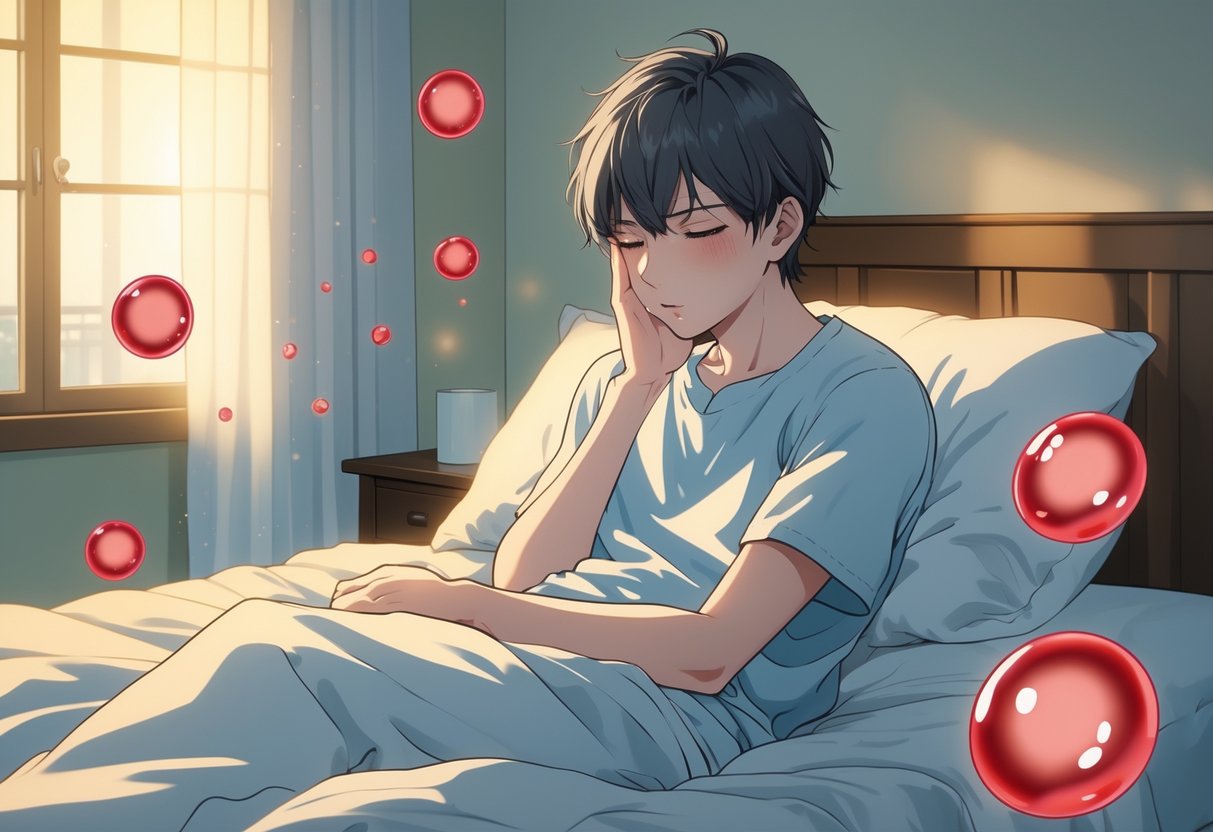
Several factors can lead to a low red blood cell count, including heavy bleeding, poor nutrition, problems with bone marrow function, and various chronic health conditions. These causes often work together and may require different treatment approaches.
Blood Loss and Bleeding
Heavy bleeding is one of the most common reasons for low red blood cell counts[7]. When the body loses blood faster than it can make new red blood cells, anemia develops quickly.
Common bleeding sources include:
- Heavy menstrual periods in women
- Stomach ulcers or intestinal bleeding
- Injuries or accidents with significant blood loss
- Frequent blood donations
Internal bleeding often goes unnoticed for weeks or months. Gastrointestinal bleeding from ulcers or cancer[7] can cause slow, steady blood loss.
Certain medications like aspirin and NSAIDs can increase bleeding risk. These drugs may cause stomach irritation and bleeding over time.
Nutritional Deficiencies
The body needs specific nutrients to make healthy red blood cells. Without enough iron, folate, or vitamin B12, red blood cell production drops significantly.
Iron deficiency is the most common nutritional cause of anemia. The body uses iron to make hemoglobin, the protein that carries oxygen in red blood cells. Low iron intake or poor iron absorption[7] leads to iron deficiency anemia.
Folate and vitamin B12 deficiencies cause different types of anemia. These vitamins help make DNA needed for new red blood cells. Without them, the body makes fewer, larger red blood cells that don’t work well.
Vegetarians and vegans face higher risks for B12 deficiency. Pregnant women need extra folate to prevent anemia and birth defects.
Bone Marrow Disorders
The bone marrow makes all red blood cells. When bone marrow doesn’t work properly, red blood cell counts drop dramatically.
Aplastic anemia occurs when bone marrow stops making enough blood cells. This rare but serious condition can be caused by certain medications, infections, or autoimmune diseases.
Blood cancers like leukemia and lymphoma affect bone marrow function. These cancers crowd out normal blood cell production with abnormal cells.
Genetic disorders like thalassemia and sickle cell disease cause problems with red blood cell formation or survival. These conditions run in families and affect red blood cell structure.
Chemotherapy treatments often damage bone marrow temporarily. This leads to low red blood cell counts during cancer treatment.
Chronic Diseases and Other Factors
Many long-term health conditions can lower red blood cell counts through different mechanisms.
Kidney disease reduces red blood cell production because kidneys make erythropoietin, a hormone that signals bone marrow to make red blood cells. Chronic kidney disease[7] often leads to anemia as kidney function declines.
Autoimmune diseases like rheumatoid arthritis and lupus can cause anemia in multiple ways. They may cause inflammation that interferes with iron use or trigger the immune system to attack red blood cells.
Chronic infections and inflammation can suppress red blood cell production. The body redirects resources to fight infection instead of making new blood cells.
An enlarged spleen can destroy red blood cells faster than the body can replace them. This condition, called hemolytic anemia, leads to low red blood cell counts despite normal bone marrow function.
Diagnosing a Low RBC Count
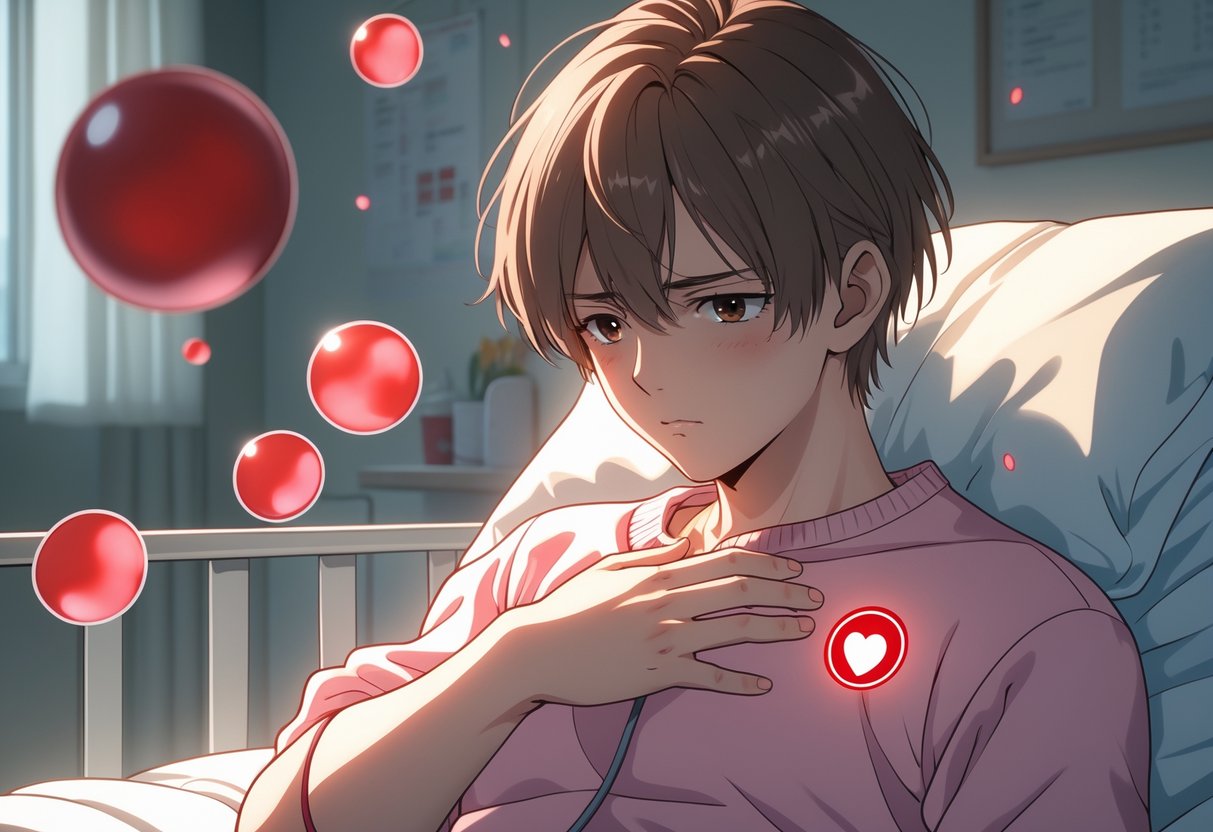
Doctors use blood tests to measure red blood cell levels and identify anemia. The main test checks hemoglobin and hematocrit levels, while additional tests help find the underlying cause.
Complete Blood Count (CBC) and Related Tests
Healthcare providers diagnose low hemoglobin by taking blood samples and measuring hemoglobin levels[6]. This test is called a complete blood count or CBC.
The CBC measures several important parts of blood. It counts red blood cells, white blood cells, and platelets. The test also checks hemoglobin and hematocrit levels.
A CBC takes only a few minutes to complete. A nurse or technician draws blood from a vein in the arm. The blood sample goes to a lab for testing.
Results are usually available within hours or by the next day. Most doctors can explain the results during the same visit or over the phone.
The CBC is often the first test doctors order when patients feel tired or weak. It helps identify anemia quickly and safely.
Interpreting Hemoglobin and Hematocrit Levels
Hemoglobin levels show how much oxygen the blood can carry. Normal hemoglobin ranges between 14.0 and 17.5 grams per deciliter for men[6]. For women, normal levels range between 12.3 and 15.3 grams per deciliter.
Severe low hemoglobin is 13 grams per deciliter or lower for men[6]. For women, severe low hemoglobin is 12 grams per deciliter or lower.
Hematocrit measures the percentage of blood made up of red blood cells. Normal hematocrit levels are:
- Men: 38.8% to 50.0%
- Women: 34.9% to 44.5%
Low hematocrit levels suggest anemia. Very low levels may require immediate treatment.
Both hemoglobin and hematocrit help doctors understand how severe the anemia is. Lower numbers mean more serious anemia.
Additional Diagnostic Investigations
Doctors may order more tests to find what causes low RBC count. They might analyze different types of hemoglobin through hemoglobin electrophoresis[6].
Blood smear tests show the size and shape of red blood cells. This helps identify specific types of anemia. Iron studies check iron levels in the blood and body stores.
Vitamin tests measure B12 and folate levels. Low levels of these vitamins can cause anemia. Bone marrow tests may be needed if other tests don’t show the cause.
Doctors might also check for internal bleeding. Stool tests can find hidden blood loss from the digestive system.
These additional tests help doctors choose the right treatment. Different causes of anemia need different treatments to work effectively.
Treatment and Management Strategies

Treatment for low red blood cells depends on the type of anemia[8] and involves three main approaches. Doctors first identify and treat the root cause, then address nutritional needs through diet and supplements, and may use medical procedures like blood transfusions in severe cases.
Addressing Underlying Causes
The first step involves finding what caused the low RBC count. If low iron is due to blood loss, such as from stomach ulcers or bowel problems, those issues need to be treated[8].
Doctors look for bleeding sources like heavy periods, stomach problems, or bowel issues. They also check for chronic diseases that affect red blood cell production.
Common underlying causes include:
- Internal bleeding from ulcers
- Heavy menstrual periods
- Kidney disease
- Cancer treatments like chemotherapy
- Autoimmune disorders
For autoimmune conditions, doctors may prescribe medications like prednisone. Patients with kidney problems might receive erythropoietin injections to help their body make more red blood cells.
Dietary Changes and Supplements
People with iron deficiency anemia need additional iron. Eating foods high in iron is not sufficient[8]. Most patients need iron supplements along with dietary changes.
Iron-rich foods include:
- Red meat and liver
- Spinach and dark leafy greens
- Beans and lentils
- Fortified cereals
Vitamin C helps the body absorb iron better. Patients should eat citrus fruits, tomatoes, or peppers with iron-rich foods.
Folate and folic acid supplements may be needed for certain types of anemia. These vitamins and minerals help the body make healthy red blood cells.
Iron supplements come as pills or liquids. Some patients need intravenous iron if their iron stores are very low or if pills cause stomach problems.
Medical Interventions and Blood Transfusions
Severe cases may require immediate medical treatment. A blood transfusion may be indicated in cases of severe iron deficiency[8].
Blood transfusions quickly raise RBC counts in emergency situations. Doctors use this when patients have dangerously low levels or severe symptoms.
Other medical treatments include:
- Erythropoietin injections to boost red blood cell production
- Bone marrow transplants for severe cases
- Immunosuppressive drugs for autoimmune types
Patients receiving chemotherapy may need special monitoring. Cancer treatments often cause low RBC counts as a side effect.
Some patients need regular follow-up blood tests to check their progress. Treatment length varies from weeks to months depending on the cause and severity.
Frequently Asked Questions
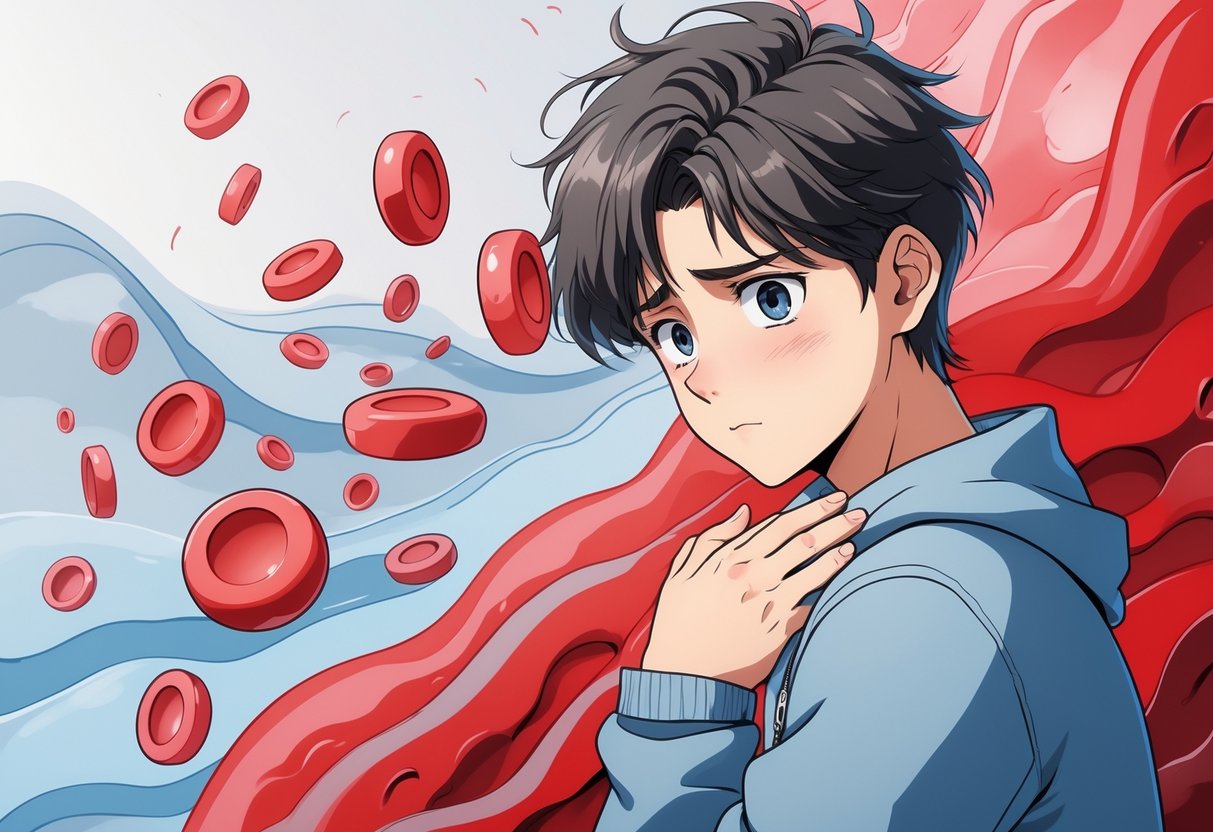
Low red blood cell counts can lead to serious health problems including organ damage and heart complications. Critical levels require immediate medical attention, while dietary changes and specific treatments can help restore healthy blood cell production.
What are the potential consequences of a low red blood cell count?
A low red blood cell count prevents the body from getting enough oxygen to its tissues and organs. The body may not be getting the oxygen it needs[5] when red blood cell levels drop too low.
The heart must work harder to pump blood throughout the body. This extra strain can lead to chest pain, rapid heartbeat, and difficulty breathing during normal activities.
Brain function suffers when oxygen levels drop. People may experience headaches, dizziness, and trouble concentrating on daily tasks.
Severe anemia can cause organ damage over time. The kidneys, liver, and other vital organs may not function properly without adequate oxygen supply.
At what threshold is a red blood cell count considered critically low?
Normal red blood cell counts range from 4.5 to 5.9 million cells per microliter for men. Women typically have counts between 4.1 to 5.1 million cells per microliter.
Mild anemia occurs when counts drop below these normal ranges. Moderate anemia develops when counts fall to 70-80% of normal levels.
Severe anemia happens when red blood cell counts drop below 50% of normal values. This level requires immediate medical treatment and may need blood transfusions.
Critical anemia with counts below 30% of normal can be life-threatening. Patients at this level need emergency medical care to prevent organ failure.
What dietary and lifestyle changes can help raise low red blood cell levels?
Iron-rich foods help the body make more red blood cells. Red meat, poultry, fish, and leafy green vegetables provide essential iron for blood cell production.
Vitamin C improves iron absorption from food sources. Citrus fruits, strawberries, and bell peppers should be eaten with iron-rich meals.
Eating foods high in iron is not sufficient[5] for people with iron deficiency anemia. Most patients need iron supplements along with dietary changes.
B vitamins, especially B12 and folate, support red blood cell formation. Eggs, dairy products, and fortified cereals provide these important nutrients.
Regular exercise can stimulate red blood cell production. However, people with severe anemia should avoid intense physical activity until their levels improve.
Are there specific conditions that cause a decrease in hemoglobin levels?
Chronic medical conditions such as diabetes, cancer, and chronic infections[5] can cause the body to keep iron away from developing red blood cells.
Autoimmune diseases like lupus can trigger the immune system to attack healthy red blood cells. This destruction leads to rapid drops in hemoglobin levels.
Blood loss from ulcers, heavy menstrual periods, or injuries depletes iron stores. The body cannot replace red blood cells fast enough without adequate iron.
Kidney disease affects the production of erythropoietin, a hormone that signals bone marrow to make red blood cells. This leads to progressively lower hemoglobin levels.
What are common treatments for low hemoglobin or red blood cells?
Iron supplementation may be given orally as pills or liquid[5] including ferrous fumarate, ferrous sulfate, and ferrous gluconate. Some patients receive iron through IV infusions when oral supplements are not absorbed properly.
Blood transfusions provide immediate relief for severe anemia. If iron deficiency anemia is severe, a blood transfusion may be needed[5] to quickly restore oxygen-carrying capacity.
Medications like erythropoietin stimulate bone marrow to produce more red blood cells. These treatments work best when combined with iron supplementation.
Treating underlying conditions is essential for long-term improvement. Doctors must address ulcers, kidney disease, or autoimmune disorders causing the low blood count.
How do doctors determine if a low blood count is indicative of cancer?
Discovering anemia is often the starting point to diagnosing an underlying condition[5]. Blood tests can reveal patterns that suggest cancer-related anemia.
A complete blood count shows all blood cell types, not just red blood cells. Cancer often affects multiple cell lines, causing low white blood cells and platelets too.
Bone marrow biopsies examine where blood cells are made. For aplastic anemia, tests may also include a bone marrow biopsy[5] to check for cancer cells.
Additional tests like CT scans and blood chemistry panels help identify tumors. Doctors look for enlarged lymph nodes, organ changes, and abnormal protein levels.
Cancer treatments themselves can cause low red blood cell counts. Most cancer treatments kill cells that grow at a fast rate[9], including healthy red blood cells.
References
- Why You Have Low RBC Count and How to Deal With It. https://www.md-health.com/low-red-blood-cell-count.html Accessed October 30, 2025
- What are the symptoms of low blood counts?. https://www.aamds.org/questions/what-are-symptoms-low-blood-counts Accessed October 30, 2025
- Anemia. https://www.hematology.org/education/patients/anemia Accessed October 30, 2025
- Red Blood Cells: Function, Role & Importance. https://my.clevelandclinic.org/health/body/21691-function-of-red-blood-cells Accessed October 30, 2025
- What Does It Mean When Your Red Blood Cells Are Low?. https://www.emedicinehealth.com/what_does_it_mean_when_red_blood_cells_are_low/article_em.htm Accessed October 30, 2025
- Low Hemoglobin: Causes, Signs & Treatment. https://my.clevelandclinic.org/health/symptoms/17705-low-hemoglobin Accessed October 30, 2025
- reasons for low red blood cell counts. https://www.verywellhealth.com/low-hemoglobin-5217077 Accessed October 30, 2025
- Low Red Blood Cell Count (Anemia): Symptoms, Causes, Treatment. https://www.emedicinehealth.com/how_do_you_treat_low_red_blood_cells/article_em.htm Accessed October 30, 2025
- Low Red Blood Cell Count (Anemia). https://www.oncolink.org/support/side-effects/low-blood-counts/low-red-blood-cell-count-anemia Accessed October 30, 2025
